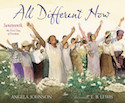
Through the eyes of one little girl, All Different Now tells the story of the first Juneteenth, the day freedom finally came to the last of the slaves in the South. Since then, the observance of June 19 as African American Emancipation Day has spread across the United States and beyond.
- ISBN: 9780689873768
- Author: Johnson, Angela
- Illustrator: Lewis, E. B.
- Published: 2014, Simon & Schuster Books for Young Readers
- Themes: African Americans, celebration, enslavement, freedom, Identity
- Descriptors: Historical Fiction, Picture Book, Primary (ages 6-9), United States
- No. of pages: 40

Jennifer:
All Different Now tells a wonderful story seen through the eyes of a young enslaved girl after the Civil War in the United States. When I first began teaching, I would hear all about Juneteenth celebrations from my students right before we recessed for the summer. The girls would tell me what they were going to wear and the boys would tell me about the epic basketball games they would soon be playing. However, I never understood or knew what Juneteenth was or why it was celebrated. The child narrator explains the origins of Juneteenth. I can feel the young girl’s excitement and curiosity about what is going on around her. One morning, she woke up enslaved and worked the fields with her family as if everything were normal. The next morning she woke up and all was different now. She was no longer enslaved.
As a teacher of African-American students, it’s very difficult to get children to understand the concept of slavery and the reality of what slavery was. The time of slavery, historically, was not so long ago. My students know what slavery is and know that it no longer exists, yet many of them would not be able to articulate what Juneteenth is and how important the celebration is in our American culture. I wonder how many slaves continued to work on plantations even after the Emancipation Proclamation. The 13th Amendment didn’t become law until 2 years after the Emancipation Proclamation. Did slaves continue to work even after the 13th amendment? News traveled slowly in the 19th century. How many slaves died before they even knew they were free?
This book can be a great catalyst for discussions about basic human rights. Teaching fifth grade, our social studies curriculum focuses on Pre-Columbian America through the writing of the Constitution. My students learn how slavery began in our country and how slavery became wide-spread in a relatively short amount of time. We talk about how Africans participated in the Revolutionary War and also the differences between being an indentured servant and a slave. We talk about the Declaration of Independence and how it was written and signed by men who were slave owners. These men literally gave up everything to commit the treasonous act of signing a declaration of sedition. We talk about the Bill of Rights and the fundamental rights that human beings have, yet my students begin to realize that these documents were written with Africans not being recognized as humans enjoying these fundamental rights. This book can begin the discussion as to how slavery really ended—through the eyes of a child who was a slave.
Kathleen:
As much as I hate to admit it, another historical event that I was unaware of until children’s literature brought it forward. I agree with Jenn that this book is a great catalyst for discussion. But I wonder though at what age would this book be most appropriate to begin discussions of this topic? As Jenn noted, 5th graders begin to grapple with the notion of slavery, and as this book is geared toward young readers, some educators may question whether 5-9 year olds too young to initiate this topic. I believe this book provides enough subtlety for young readers, but still provides insight for older readers to see this aspect of history that is not typically brought out in a view of slavery.
Angela Johnson’s strength, is her use of poetic language, which encourages the reader to walk through the text and illustrations slowly. I was particularly drawn into the watercolor illustrations of E.B. Lewis, where I could feel the warmth of the day, the smell of the honeysuckle, and feel the freedom that a mother shares with her daughter. Johnson and Lewis through text and drawings show this well in a full page illustration and simple, but moving words on the other: “My mama held my hand softly and looked beyond, as another breeze blew over and everything fell to a hush.” Johnson’s language is simple, but conveys the notion of a respected celebration, one that is not in the mainstream American history.
This author and illustrator both provide notes at the end that offer a bit more detail of this day in history. Angela Johnson’s notes relay her family history and how the idea for this book took shape. E.B. Lewis’s notes are particularly moving where he states, “I hope this book will act as a beacon that shines its light on a dark corner of our country’s history and lays bare its collective denial. Once the darkness is illuminated, a deeper healing can occur and better assure our children’s future. A future where all people wholeheartedly embrace and happily celebrate our differences.”